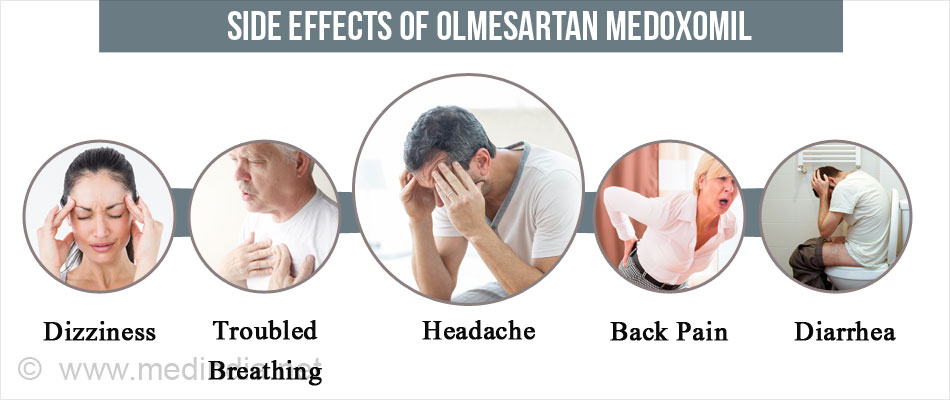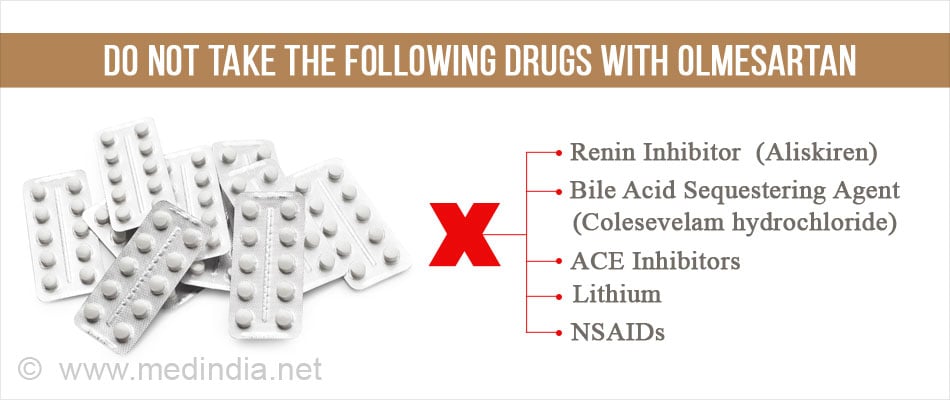- Brunner HR. Olmesartan Medoxomil medoxomil: current status of its use in monotherapy. Vascular Health and Risk Management. 2006;2(4):327-340.
- Andrew Whittaker. A Review of Olmesartan Medoxomil Medoxomil -- A New Angiotensin II Receptor Blocker. Br J Cardiol. 2005;12(2):125-12.
- Olmesartan - (https://en.wikipedia.org/wiki/olmesartan%20medoxomil)
- Label: OLMESARTAN MEDOXOMIL- olmesartan medoxomil tablet, film coated - (https://medlineplus.gov/druginfo/meds/a603006.html)
- About Olmesartan - (https://dailymed.nlm.nih.gov/dailymed/druginfo.cfm?setid=58a1371d-bf52-4dcf-a504-4c9eee565c02)
What is Olmesartan Medoxomil?
Olmesartan Medoxomil is indicated for the treatment of high blood pressure or hypertension. It was developed by the Japanese pharmaceutical company Sankyo in 1995. Olmesartan is administered as an ester pro-drug called Olmesartan medoxomil and is completely and rapidly hydrolyzed to the active acid form.
Olmesartan Medoxomil can be used alone or in combination with other anti-hypertensive drugs in adults and children who are 6 years or older.
High blood pressure that is not treated over a period of time can cause damage to the arteries of the heart, brain, eyes and kidneys. Complications that could arise by not controlling your blood pressure are heart disease like heart attacks and heart failure, stroke, kidney failure and loss of vision.
Lifestyle changes are as important as taking medications in the case of high blood pressure. Maintaining a low-fat and low-salt diet and a healthy weight, exercising 30 minutes for most days, not smoking and using alcohol in moderation are some of the changes that have to be incorporated into the daily routine.
What is Blood Pressure?
Blood pressure is the product of cardiac output (CO) and peripheral resistance (PV).
Cardiac output is the amount of blood pumped by the heart per minute and is the product of the heart rate (the beats per minute) and the stroke volume (amount of blood pumped per beat). Peripheral resistance is the resistance to the blood flow in the arteries.
An increase in cardiac output or peripheral resistance can increase blood pressure. Cardiac output increases when there is excess sodium re-absorption by the kidneys that causes water retention in the body. Peripheral resistance increases when the arteries constrict thereby increasing the resistance to blood flow.
What is the Mechanism of Action of Olmesartan Medoxomil?
Olmesartan Medoxomil belongs to the class of drugs known as angiotensin 2 receptor blockers or ARBs that block the binding of angiotensin 2 to its receptor.
Angiotensin 2 is a part of the renin-angiotensin-aldosterone system (RAS), an important pathway through which many of the anti-hypertensive drugs work.
Angiotensin 2 causes
- Tightening of blood vessels (systemic vasoconstriction in the arteries).
- Increase in sodium re-absorption and as a result increased water retention in the kidney tubules. This results in increase in blood volume, forcing the heart to pump out more blood while contracting. This increases cardiac output.
- Release of a steroid hormone aldosterone that also acts to increase sodium and water retention.
Vasoconstriction and sodium re-absorption cause an increase in blood pressure.
When ARBs like Olmesartan Medoxomil block angiotensin 2 from binding to its receptor:
- The blood vessels stay open (vasodilation).
- There is reduction in the secretion of aldosterone.
These effects reduce blood pressure. Blood flows more smoothly through the blood vessels and the heart is able to pump more efficiently.
What are the Uses of Olmesartan Medoxomil?
Olmesartan Medoxomil is indicated in the following condition:
- Hypertension (either alone or in combination with diuretics).
It is also sometimes used in the following conditions:
- Heart failure (when the heart is unable to pump enough blood to the rest of the body).
- Diabetic nephropathy (a chronic kidney disease in people with diabetes).
ARBs in general are also known to improve the chances of survival after a heart attack.
What are the Side Effects of Olmesartan Medoxomil?
Olmesartan Medoxomil could cause the following side effects:
- Headache
- Back pain
- Diarrhea - Chronic diarrhea with substantial weight loss may require discontinuation of treatment
- Dizziness
- Allergic reaction that may cause troubled breathing or swallowing, and swelling in any part of the face
- Upper respiratory tract infection with symptoms like hoarse voice and cough
- Increase in blood potassium levels
- Low blood pressure in those with low blood volume or low sodium levels

What are the Contraindications of Olmesartan Medoxomil?
Olmesartan Medoxomil is contraindicated in:
- Pregnant women, especially in the second and third trimesters as it can cause reduced fetal renal function and increase the risk of fetal injury and death. It can also cause fetal malformations including skeletal deformities.
- Children under 1 year old as it can affect the development of their kidneys.
- Patients with diabetes who are also taking another drug called aliskiren
- Patients with stenosis of the renal arteries (narrowed arteries supplying the kidney).
What are the Doses and Combinations of Olmesartan Medoxomil given for Hypertension?
1. Olmesartan Medoxomil alone:
Adults: A starting dose of 20 milligrams (mg) per day as a tablet is prescribed to be taken orally which can be increased after 2 weeks to 40 mg per day. It can be taken with food or on an empty stomach. There is no advantage of consuming more than 40 mg a day or splitting the dose into 2 per day.
Like other anti-hypertensive medications, Olmesartan Medoxomil only keeps the blood pressure under control and does not cure it. The blood pressure may decrease in the first week of treatment but you require up to 2 weeks to experience the full benefit of the drug.
Children (6 to 16 years): The dose is based on body weight and can be given a tablet or oral suspension. Usually between 20 to 40 mg per day (for children weighing above 35 kilograms) and between 10 to 20 mg per day (for children above 20 kg and less than 35 kg) is given.
It is not effective in children less than 6 years and should not be given to infants less than 1 year.
2. Combination therapy: Olmesartan Medoxomil can also be taken in combination with other anti-hypertensive agents.
With hydrochlorothiazide:
Hydrochlorothiazide acts as a diuretic increasing the flow of urine out of the body thereby reducing the amount of water in the body. This lowers the blood pressure.
Adults: One tablet a day
Children: As prescribed by the doctor.
With hydrochlorothiazide and amlodipine:
Amlodipine is a calcium channel blocker that acts by blocking the flow of calcium into the cells of the heart and blood vessels. Effects are relaxing the blood vessels thus lowering blood pressure.
Adults: One tablet a day (the maximum dose per day for Olmesartan Medoxomil should be 40 mg, for hydrochlorothiazide should be 25 mg and for amlodipine should be 10 mg).
Children: As prescribed by doctor.
What are the Drug Interactions of Olmesartan Medoxomil?
Most drugs consumed are changed into more soluble forms before they are excreted from the body. The predominant enzymes in the conversion of drugs belong to a complex called the cytochrome P450 (CYP) complex that is mostly present in the liver but can be present in other organs too.
Olmesartan Medoxomil is not metabolized by the cytochrome P450 pathway. It is not expected to have any interactions with drugs that increase, decrease or are metabolized by the CYP enzymes.
Olmesartan Medoxomil is excreted as the unchanged drug.
Olmesartan Medoxomil should not be administered with aliskiren in patients with diabetes. Aliskiren is a renin inhibitor used to treat hypertension. Since aliskiren also works through RAS the dual blockade of the system could cause altered sodium and potassium levels and renal impairment.
Olmesartan Medoxomil should not be consumed with certain other drugs and in certain conditions. The dosage or the interval of dosing can be changed after consulting with your doctor.
- Colesevelam hydrochloride is a bile acid sequestering agent. When taken together, colesevelam reduces the availability of Olmesartan Medoxomil. Hence stagger the timings.
- Angiotensin converting enzyme (ACE) inhibitors are used to treat hypertension (benazepril, captopril, enalapril, fosinopril, lisinopril, moexipril, perindopril, quinapril, ramipril or trandolapril). These also work through the RAS system. This dual blockade of the system could cause low blood pressure, increase in potassium levels and kidney impairment.
- Lithium is used to treat bipolar disorder. When take together lithium toxicity could occur; hence monitoring lithium levels is important.
- When Non-steroidal anti-inflammatory agents or NSAIDs are used by the elderly or those who have compromised renal function, co-administration with Olmesartan Medoxomil may cause renal impairment; monitor the renal function regularly in patients who take Olmesartan Medoxomil with any of the NSAIDs.
Olmesartan Medoxomil is not affected by food and can be taken along with digoxin, warfarin and antacids.







